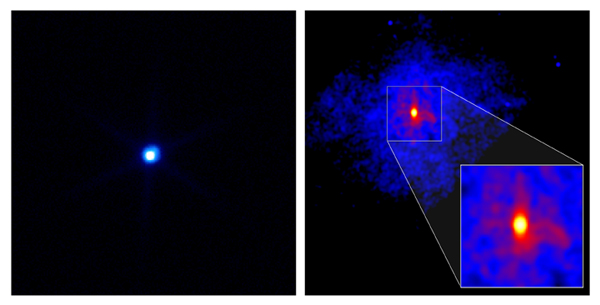

|

|
|
||||
|
RX J1856.5-3754 (left): A compact star about
400 light years from Earth in the constellation Corona
Australis. 3C58 (right): A supernova remnant with a central pulsar about 10,000 light years from Earth in the constellation Cassiopeia. Caption: Chandra observations of RX J1856.5-3754 suggest that the matter in this collapsed star is even denser than nuclear matter, the most dense matter found on Earth. X-ray and optical data indicate that RX J1856 has a diameter of only 7 miles. This size is too small to reconcile with the standard models of neutron stars. One exciting possibility is that the high density inside the star has caused the neutrons to dissolve into a soup of up, down, and strange quarks to form a strange quark star, which would have a smaller radius. Observations of 3C58, the remnant of a supernova noted on Earth in AD 1181, reveal that the pulsar in the core has a temperature much lower than expected. This suggests that an exotic, denser state of matter might exist inside this collapsed star. Scale for RX J1856.5-3754: Image is 20 arcsec on a side. Scale for 3C58: Image is 7.2 arcmin on a side (pullout box is 1.4 arcmin). Chandra X-ray Observatory HRC/LETG (RX J1856) & ACIS (3C58) Image
CXC operated for
NASA by the Smithsonian Astrophysical
Observatory
|
|
|